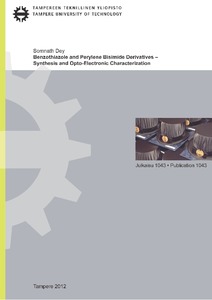Benzothiazole and Perylene Bisimide Derivatives - Synthesis and Opto-Electronic Characterization
Dey, Somnath (2012)
Dey, Somnath
Tampere University of Technology
2012
Luonnontieteiden ja ympäristötekniikan tiedekunta - Faculty of Science and Environmental Engineering
This publication is copyrighted. You may download, display and print it for Your own personal use. Commercial use is prohibited.
Julkaisun pysyvä osoite on
https://urn.fi/URN:ISBN:978-952-15-2858-3
https://urn.fi/URN:ISBN:978-952-15-2858-3
Tiivistelmä
This work investigates the tuning of photophysical properties of two different classes of photoactive molecules, 2-(2’-hydroxyphenyl)benzothiazole (HBT) and perylene bisimide (PBI). The Suzuki coupling reaction was employed to synthesize aryl-substituted derivatives of HBT and PBI. The tuning of the photophysical properties of both HBT and PBI was successfully carried out by attaching either electrondonating (ED) or electron-withdrawing (EW) aryl moieties to the parent compounds. For HBT, a series of 5-substituted derivatives were synthesized to modify the highest occupied molecular orbital (HOMO) energy levels of zinc-benzothiazole (Znb₂) complexes. Perylene bay substitutions were used to tune the HOMO-LUMO (LUMO: lowest unoccupied molecular orbital) energy gap of the diaryl-PBIs.
Spectroscopic and electrochemical techniques were used to determine the effects of substituents on the photophysical properties to the parent compounds. For the Znb₂ complexes, absorption and emission spectra as well as the HOMO energy levels are effectively modified by the aryl-substitution while the LUMO energy level remains largely unaffected. Whereas, for the PBI derivatives, the spectroscopic profiles as well as the HOMO and LUMO energy levels were tuned by the attached aryl groups. These results indicate that inductive effects are more dominant in both Znb₂ and PBI derivatives.
All the involved reactions, especially borylation of both the HBT and PBI were studied in detail to achieve maximum yield and simple purification. The separation of a series of 1,7- and 1,6-diaryl-PBIs by normal column chromatography was an important step in perylene chemistry. The individual regioisomers of diaryl-PBIs were unambiguously characterized by observing the chemical shifts of α- methylene protons using 300 MHz ¹H NMR spectroscopy. Obtained results indicate that both 1,7- and 1,6-regioisomers of same diaryl-PBI possess slightly different opto-electronic properties, which might be important while designing a system for optical devices.
Moreover, the synthesized Znb₂ complexes were used as anode buffer layers in thin film bulk-hetero junction (BHJ) based inverted organic solar cells. The presence of vacuum evaporated Znb₂ buffer layers was found to enhance the photovoltaic performance by up to 40 % when compared to a similar device containing tris(8-hydroxyquinlinato)aluminum(III) (Alq₃) buffer layer. The device stability also improved considerably when compared to the corresponding device with the Alq₃ buffer layer.
Finally, benzothiazole-perylene bisimide (HBT-PBI) dyads, in which two chromophore units were linked in close proximity to each other, were synthesized and studied by optical spectroscopy to explore a new donor-acceptor light-harvesting photovoltaic antennae system.
Spectroscopic and electrochemical techniques were used to determine the effects of substituents on the photophysical properties to the parent compounds. For the Znb₂ complexes, absorption and emission spectra as well as the HOMO energy levels are effectively modified by the aryl-substitution while the LUMO energy level remains largely unaffected. Whereas, for the PBI derivatives, the spectroscopic profiles as well as the HOMO and LUMO energy levels were tuned by the attached aryl groups. These results indicate that inductive effects are more dominant in both Znb₂ and PBI derivatives.
All the involved reactions, especially borylation of both the HBT and PBI were studied in detail to achieve maximum yield and simple purification. The separation of a series of 1,7- and 1,6-diaryl-PBIs by normal column chromatography was an important step in perylene chemistry. The individual regioisomers of diaryl-PBIs were unambiguously characterized by observing the chemical shifts of α- methylene protons using 300 MHz ¹H NMR spectroscopy. Obtained results indicate that both 1,7- and 1,6-regioisomers of same diaryl-PBI possess slightly different opto-electronic properties, which might be important while designing a system for optical devices.
Moreover, the synthesized Znb₂ complexes were used as anode buffer layers in thin film bulk-hetero junction (BHJ) based inverted organic solar cells. The presence of vacuum evaporated Znb₂ buffer layers was found to enhance the photovoltaic performance by up to 40 % when compared to a similar device containing tris(8-hydroxyquinlinato)aluminum(III) (Alq₃) buffer layer. The device stability also improved considerably when compared to the corresponding device with the Alq₃ buffer layer.
Finally, benzothiazole-perylene bisimide (HBT-PBI) dyads, in which two chromophore units were linked in close proximity to each other, were synthesized and studied by optical spectroscopy to explore a new donor-acceptor light-harvesting photovoltaic antennae system.
Kokoelmat
- Väitöskirjat [4773]
